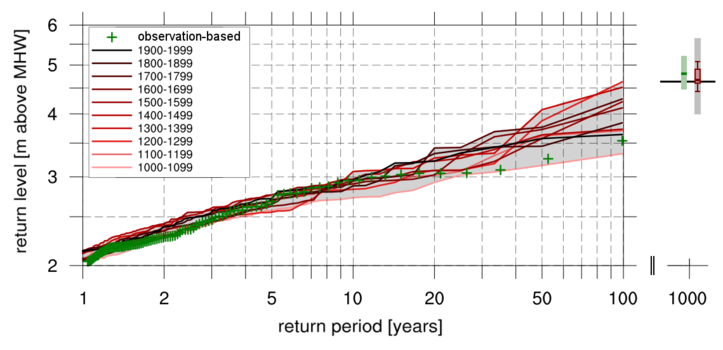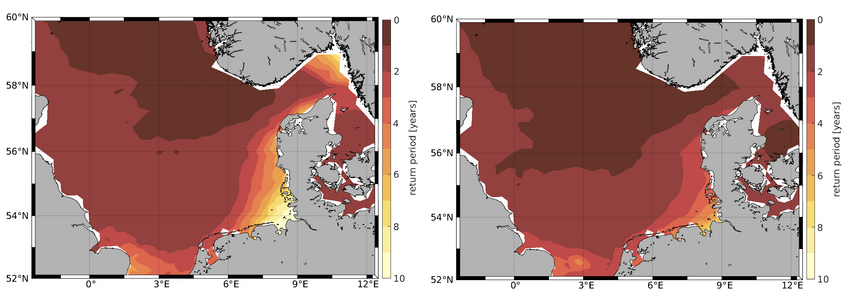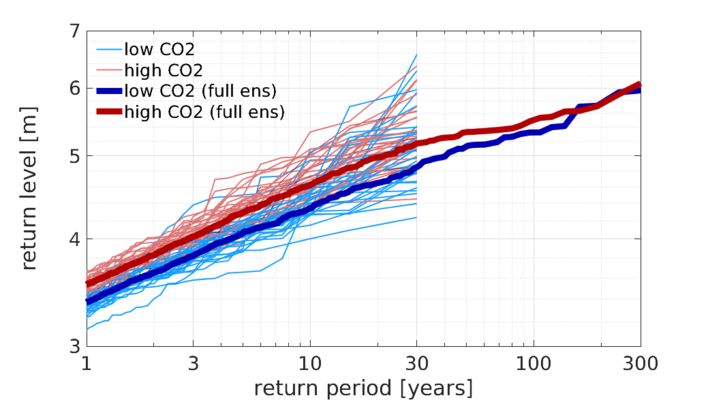Past and Future Variability of Extreme Storm Floods in the southern North Sea
The low-lying coasts of the southern North Sea are particularly exposed to extreme sea levels (ESL) in form of storm floods. Due to anthropogenic climate change, the risk of flooding is expected to increase in the future (IPCC, 2019). Adequate and timely coastal protection relies on estimates of expected heights and frequencies of such ESL events, particularly of the policy-relevant high-impact-low-probability events. Yet, since by definition, extreme events occur only rarely, their very nature complicates a robust estimation of trends and variability in past and future. As high-frequency tide gauge records typically only range back a couple of decades to 100 years, long-term climate model simulations can help to extend the record and to infer long-term ESL statistics. However, since such global climate model simulations have an insufficient resolution to adequately simulate the small scale shelf processes, a regional approach is necessary.
We downscale global climate model simulations from MPIOM-ECHAM with the regionally coupled atmosphere-ocean-sea ice model MPIOM/REMO (for details on the coupling see Sein et al., 2015 or Mathis et al., 2018) to (1) quantify the long-term variability of ESLs over the last millennium and (2) to project future changes in their statistics by downscaling large ensemble experiments. Compared to previous studies, the resulting large sample of extreme values allows a statistically robust estimation of the policy-relevant high-impact-low-probability events. At the same time, the dynamical downscaling with high-frequency ocean-atmosphere coupling provides both a sufficiently high resolution to adequately simulate high-frequency sea level variations and a globally consistent simulation of associated climate states.
1. Quantification of long-term variability
We downscale a global Earth System Model simulation from the PMIP3 past1000 project (Jungclaus et al., 2014; Moreno-Chamarro et al., 2017) to investigate the long-term variability of ESLs in the southern North Sea during the last Millennium with respect to large-scale drivers in the climate system.
In our downscaled simulations ESL statistics vary substantially on interannual to centennial timescales without following preferred oscillation periods. High-impact-low-probability extremes such as the 100-year return level (a level that is reached, on average, once every 100 years) vary by more than one meter throughout the last Millennium, depending on the baseline period considered (Fig. 1). Due to this large variability, ESL variations mask any signals from background sea level variations or from external natural variability such as solar or volcanic forcing.
The high ESL variability emphasizes the inherent uncertainties related to traditional extreme value estimates based on short data subsets, which fail to account for such long-term variations. This suggests that uncertainties related to high-impact-low-probability estimates are higher than previously assumed, and that estimates used for flood protection standards strongly depend on the state of long-term variability.

2. Future change in extreme storm flood statistics
We also investigate future changes in ESL statistics under climate change which occur on top of a gradual rise in mean sea level. A rising mean sea level directly affects ESL heights by raising the baseline for extremes to act on. However, while many studies estimate future ESLs by simply scaling the sea level distribution with global or regional mean sea level rise estimates (e.g. SROCC, 2019), an equivalent shift of extreme values does not a priori hold for the future. Additionally, changes in, e.g., the large-scale storminess or the regional storm pattern, may occur due to anthropogenic climate change and may alter future ESL statistics.
To account for the large ESL variability detected in the last Millennium simulation (see above), we downscale a large ensemble of 32 members of the global 1pctCO2 scenario simulations from the MPI Grand Ensemble (Maher et al., 2019). This is an idealistic and comparably strong emission scenario in which the atmospheric CO2 concentration increases by 1% annually for 150 years, starting at preindustrial levels. Its forcing is thus stronger than the high emission scenario of the representative concentration pathway family (RCP8.5). The large ensemble creates a plethora of simulated extremes and thus allows a statistically robust estimation of changes in high-impact-low-probability events. To investigate the climate change response on ESL statistics, we compare pooled ensemble statistics of 30-year periods at the beginning and end of the simulation, relative to mean sea level.
First results indicate that with rising atmospheric CO2 levels, ESLs in the German Bight do not only scale with mean sea level rise but increase additionally, particularly along the western coastlines of Schleswig-Holstein and Denmark (Fig. 2). Here, the magnitude of the ESL response reaches around half of what the regional mean sea level alone is projected to rise until the end of the century. This ESL response is related to an enhanced large-scale activity along the North Atlantic storm belt, more predominant storms of the major West-Northwest track-type, and a subsequent local increase in mainly westerly wind speed extremes.
Yet, although the full ensemble reveals that, statistically, ESLs may rise stronger than previously assumed, individual realizations can exhibit highly different responses (Fig. 3). That is, as manifestations of the large internal variability, (multi-)decadal deviations from the statistical long-term trend are possible.


References:
IPCC (2019). IPCC Special Report on the Ocean and Cryosphere in a Changing Climate [H.-O. Poertner, D.C. Roberts, V. Masson-Delmotte, P. Zhai, M. Tignor, E. Poloczanska, K. Mintenbeck, A. Alegria, M. Nicolai, A. Okem, J. Petzold, B. Rama, N.M. Weyer (eds.)] Tech. rep. In press. IPCC.
Jungclaus, J. H., Lohmann, K., and Zanchettin, D.: Enhanced 20th-century heat transfer to the Arctic simulated in the context of climate variations over the last millennium, Clim. Past, 10, 2201–2213, https://doi.org/10.5194/cp-10-2201-2014, 2014.
Maher, N., S. Milinski, L. Suarez-Gutierrez, M. Botzet, L. Kornblueh, Y. Takano, J. Kröger, R. Ghosh, C. Hedemann, C. Li, et al.: The Max Planck Institute grand ensemble-enabling the exploration of climate system variability. Journal of Advances in Modeling Earth Systems 11, pp. 2050–2069, https://doi:10.1029/2019MS001639, 2019.
Mathis, M., Elizalde, A., and Mikolajewicz, U.: Which complexity of regional climate system models is essential for downscaling anthropogenic climate change in the Northwest European Shelf?, Clim. Dynam., 50, 2637–2659, https://doi.org/10.1007/s00382-017-3761-3, 2018.
Moreno-Chamarro, E., Zanchettin, D., Lohmann, K., Luterbacher, J., and Jungclaus, J. H.: Winter amplification of the European Little Ice Age cooling by the subpolar gyre, Sci. Rep., 7, 9981, https://doi.org/10.1038/s41598-017-07969-0, 2017.
Sein, D. V., Mikolajewicz, U., Gröger, M., Fast, I., Cabos, W., Pinto, J. G., Hagemann, S., Semmler, T., Izquierdo, A., and Jacob, D.: Regionally coupled atmosphere-ocean-sea ice-marine biogeochemistry model ROM: 1. Description and validation, J. Adv. Model. Earth Sy., 7, 268–304, https://doi.org/10.1002/2014MS000357, 2015.
